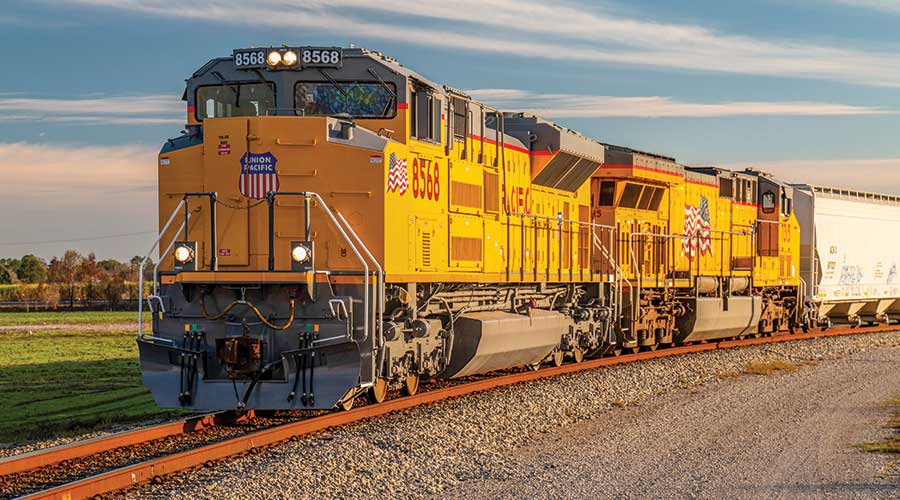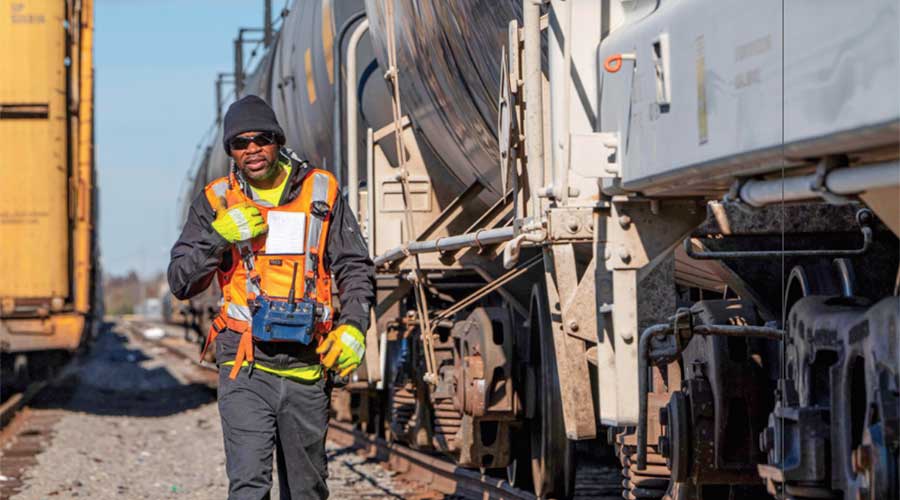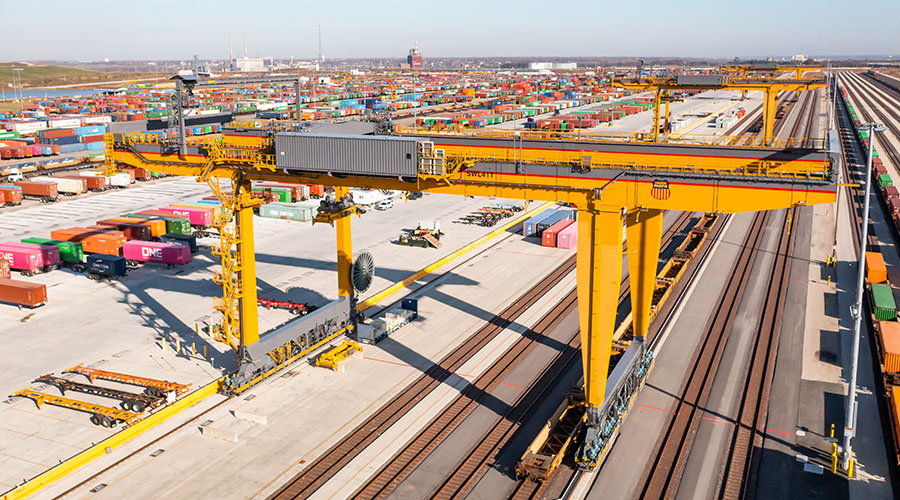Stay updated on news, articles and information for the rail industry
March 2021
Rail News: Shippers
To spur growth, Union Pacific aims to become more responsive, resourceful and reliable
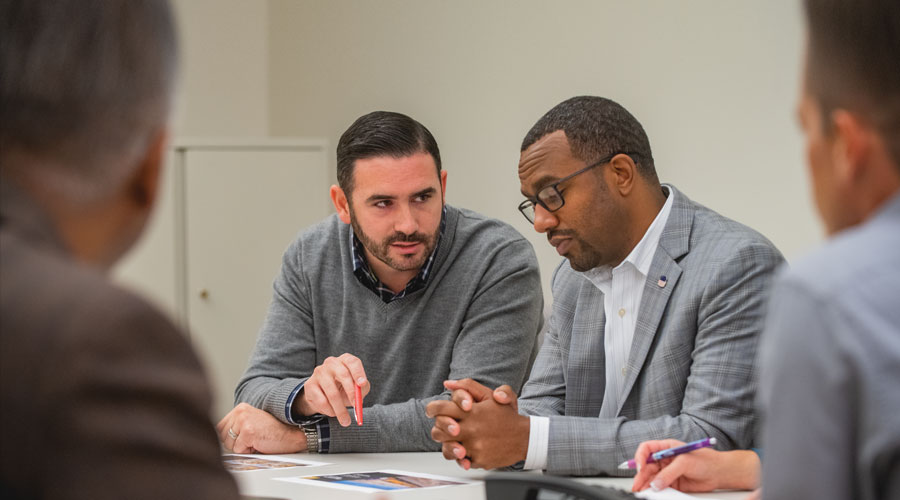
By Jeff Stagl, Managing Editor
Way back in 1975, singer Andrea True released the song “More, More More” that became a big disco hit. The lyrics include the familiar lines “More, more, more. How do you like it, how do you like it?”
At Union Pacific Railroad, they like it a lot. As in generating more traffic, market share, revenue, income and earnings, as well as in taking more steps toward obtaining the holy grail of a 55 operating ratio (OR).
To achieve those goals, UP leaders are trying to position the company to be more agile, flexible, nimble and creative, and in some nontraditional ways to boot. They also are championing efforts to foster a more diverse, inclusive and gender-equal workforce; more cultural mindset changes; more influxes of innovation and automation; more productivity, consistency and efficiency; more asset utilization; more capital discipline; and more capacity.
Although last year was a difficult one to navigate while continuing its pursuits because of the pandemic, UP still gained some promising financial results from all the expended elbow grease. Although 2020 revenue fell 10% to $19.5 billion, volume dipped 7% to 7.75 million units and adjusted operating income declined 5% to $8.1 billion compared with 2019 results, operating expenses dropped 11% to $11.7 billion and the OR improved 0.7 points to 59.9 — or to a best-ever 58.5 when adjusted for a charge tied to the scaled-down Brazos Yard project.
Moreover, due to the continued implementation of precision scheduled railroading principles through the Unified Plan, the Class I logged uplifting 2020 operational results, as well. On a year-over-year basis, freight-car velocity improved 6%, average terminal dwell dropped 8%, locomotive productivity climbed 14%, workforce productivity improved 11%, average train length grew 14% and intermodal car trip plan compliance improved 6 points.
The railroad also made strides in reducing its impact on global warming, enhancing the customer experience, growing market share in various commodities and bolstering key infrastructure. For the remainder of 2021 and beyond, more positive outcomes are anticipated, UP leaders believe.
“Our enhanced service product combined with a lower cost structure is helping [us] win in the marketplace and grow,” said UP Chairman, President and Chief Executive Officer Lance Fritz Jan. 21 during the Class I’s fourth-quarter earnings conference. “Our team is energized about the prospect of an improving economy that only expands the opportunity to win new business.”
Following are new, ongoing or renewed efforts in several key areas that the railroad’s leaders are counting on to continue transforming UP into a more resourceful, responsive and reliable company.
Rethinking technology
Now a 160-year-old company, UP has a long history of attempting to harness and leverage technologies to improve operations and spur growth.
Looking ahead, UP needs to move from an output-based to an outcome-based company to provide more visibility in the supply chain and run intelligent train operations, says Rahul Jalali, the Class I’s senior vice president of information technologies and chief information officer. The move also would prompt enterprise-wide thinking so everyone from tech teams to senior leadership are on the same page and speaking the same outcome language.
Too many organizations are held back by an antiquated information technology (IT) mindset that separates technology teams from the rest of a business, Jalali says. He joined UP in November 2020 after serving Walmart Inc. for 23 years, most recently as VP of Walmart International. The drive to become outcome-based companies is more common in the retail industry and among high-tech firms, Jalali says.
UP is in the initial stages of the transition. To further it, the Class I needs to measure and define outcomes, avoid siloed processes, forge a deeper engagement with customers, connect application programming interfaces (APIs) into customer supply-chain ecosystems, gain more predictability in operations and deliver ways to be more agile in shorter time spans, says Jalali. APIs can be built off of strong technology platforms.
“Other companies run on platforms. A move to strong tech platforms, as that comes to fruition, becomes the basis to an outcome-focused company,” says Jalali.
The challenge is to never believe you’ve arrived.
“It’s a perpetual journey,” says Jalali.
UP also needs to develop a product-thinking culture focused on obsessing over customer problems, and on value and business outcomes. In addition, product teams should be empowered, services should be delivered fast and often, and a clear set of key performance indicators should be established to measure success and progress.
“Our technology team understands the importance of continuous and rapid testing, and learning and mitigating the risks,” says Jalali. “We know that great products are the result of true collaboration. Product thinking is helping create the vision.”
UP’s other technological pursuits include adopting NetControl and UP Vision. NetControl is the Class I’s next-generation logistics and transportation management platform that will replace the mainframe-based Transportation Control System. Some of the platform is available now, with the remainder expected to become available later this year.
Launched in late 2020, UP Vision is an internally used application that allows users to view active trains in the network in a more graphical manner. Filters can be used to obtain information on train length/equipment count, train timeliness, crew availability and other factors.
“UP Vision is something we were able to deliver in weeks and months instead of months and years. We need to find ways to do things in weeks,” says Jalali. “We want to have an appetite for experimentation. You don’t have to be 100% right all the time.”
In addition, UP is gaining technological benefits from its PS Technology (PST) subsidiary, which develops solutions for the broader rail industry.
For example, PST is developing Precision Train Builder (PTB), which is designed to harness the physics associated with trains and train operations. It will simulate trains and their operations over hundreds of miles of track compressed into minutes to more accurately identify where to place rail cars within a train, how much power is needed, and where to place locomotives for the most efficient and safe operation.
“PTB looks at human factors of train operations and aims to take them out to prevent derailments,” says Jalali.
Workforce development
When it comes to honing a workforce that better reflects today’s society and suits UP’s needs, efforts to pursue diversity, inclusion and gender equality are both practical and the right things to do, says Beth Whited, the Class I’s executive VP and chief human resource officer.
“A diverse workforce is a more effective workforce,” she says. “It’s also more productive if it includes people with different backgrounds and ideas who can chime in.”
(Read more about UP’s diversity efforts, including other Whited comments, by subscribing to Progressive Railroading’s RailPrime premium content site.)
To ensure more women and minorities are employed at UP, the railroad by 2030 plans to at least double women’s share of the workforce from a “light” 5% to 11%, and boost minorities’ share from 30% to 40%, says Whited. The hiring pool can be enlarged by trying to recruit all types of people.
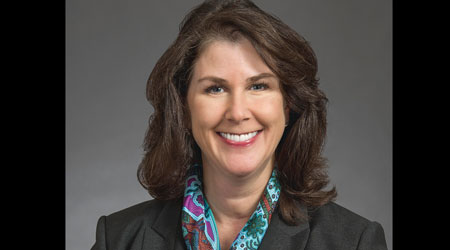
“We want a workforce that represents a community, and a [typical] community doesn’t just have 5% women and 30% minorities,” says Whited.
UP needs to make its jobs more appealing to women and minorities for the longevity of the company, she believes. Twenty-five percent of women employed at the railroad are in non-union jobs and only 2% — if rounded up — are in unionized positions. The company is light on females holding positions in IT or in civil, electrical or other engineering posts, says Whited.
“The very light area is the crafts,” she says.
Since businesses like railroads face a growing shortfall of skilled trade workers due to fewer people choosing to learn a trade, solutions need to be found to remove potential barriers for women entering that line of work, Whited believes.
To that end, UP is partnering with The Manufacturing Institute, the National Association of Manufacturers’ workforce development and education partner, on a $3 million, three-year joint initiative called Careers on Track. The initiative is designed to inspire more women and youth to pursue modern industry careers through workforce development and career solutions.
Careers on Track will offer a new digital science, technology, engineering and math (STEM) curriculum, virtual STEM experience and STEM micro-grant program for young people. It also will include a digital campaign to showcase industry career opportunities for underserved women in select regions.
“These types of partnerships are important for us because they broaden our reach,” says Whited. “We run pilot programs of our own, but it’s difficult for us to make those available in every school in our territory.”
UP also conducts hiring campaigns at its largest locomotive repair shop in Little Rock, Arkansas, as well at its shop in North Platte, Nebraska.
“It helps flow women to mechanical jobs,” says Whited.
In addition, the Class I is analyzing its hiring funnel to figure out why the railroad is losing potential women recruits to other jobs. A software program analyzes UP job postings to determine if they are too slanted to a particular gender.
“Ours tend to be slanted too much to males,” says Whited.
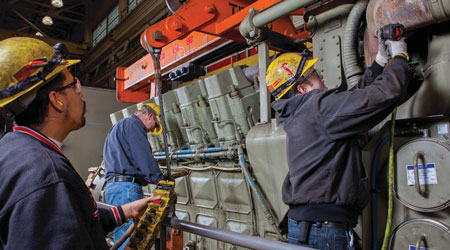
The company has found it needs to fix words in job postings such as “proficient.” About 60% of men believe they are very proficient at something while most women wouldn’t use that word to describe any of their skills, says Whited.
“We need to tear down any barriers we create ourselves,” she says.
Since minorities are underrepresented in non-agreement positions, UP tries to play up the jobs it offers at its Omaha headquarters during college recruiting. It’s difficult to attract minorities in and around that Nebraska city, Whited says.
Environmental stewardship
Another important part of UP’s transformational quest is something that’s garnered a lot more attention from large Class I shareholders of late: environmental, social and governance (ESG) efforts. The railroad remains committed to being a better environmental steward and more responsible company, says Whited.
UP’s ESG strategy is built on four areas of concentration: engaging employees, gaining sustainable solutions, protecting the environment and strengthening communities. The strategy addresses the evolving needs of the railroad’s stakeholder groups over the next decade and is more inclusive of the company’s overall impact, says Whited.
That strategy gained a boost last month when UP learned its science-based targets determining how much and how quickly the company can reduce greenhouse gas emissions (GHG) were approved through the Science Based Targets initiative (SBTi). By 2030, the Class I is targeting 26% reductions of certain GHG emissions against a 2018 baseline. SBTi independently assesses corporate emission reduction targets in line with what climate scientists say is needed to meet Paris Agreement goals.
Task teams analyze everything from soup to nuts, including the fuels the Class I consumes, says Whited.
“The science-based targets are big to us,” she says. “We know the locomotive is the big emissions factor.”
Although there’s some buzz on electrification, a radical move to that type of power is a long way off, says Whited. For now, UP is studying battery, hydrogen and other fuel sources for locomotives.
“We are looking for pilots and programs on the locomotive side. That has the potential to make a real difference,” says Whited.
UP also ranks among the CDP’s top 7% for supplier engagement. Formerly the Carbon Disclosure Project, the CDP is a nonprofit organization that helps companies disclose their environmental impact.
“Last year, we spent $400 million with diverse suppliers. We want to build up supplier capabilities to meet new needs,” says Whited. “Customers have their own efforts on ESG. We are winning business because of ESG.”
Enhancing the customer experience
To retain customers and attract new ones, the railroad needs to be easier to do business with, UP leaders believe. That means improving the customer experience and boosting customer engagement are paramount, says EVP of Marketing and Sales Kenny Rocker.
The Class I uses journey maps that help marketing and sales officials “walk in customers’ shoes” to observe the ease or difficulty of billing, car ordering and other railroad processes, he says.
“We get feedback and attack areas that are pain points,” says Rocker. “We have inserted more technologies to engage customers and to give customers full visibility in the supply chain.”
UP uses a number of APIs to provide real-time information that enables shippers to prep for upcoming service or monitor their freight in transit. A customer then can better plan their transportation operations and gain efficiencies, says Rocker.
For example, a “We’re On Our Way” app enables customers that subscribe to receive a real-time notification when their facility is next in line to be served by a train crew. Launched in early 2018 as a “You Are Next” app, We’re On Our Way provides an alert via email or mobile device.
“It helps the next customer get a crew together and unlock their gate,” says Rocker. “More carload customers are using the app.”
The Class I also offers a UPGo mobile app designed to expedite a customer’s intermodal terminal experience. Launched in fall 2019, the app offers pre-ingate and pre-outgate validation, real-time parking updates and other benefits that help reduce gate errors and dwell time. A customer can use UPGo at any of the railroad’s intermodal terminals to schedule when a container is dropped off or picked up.
“They gain clarity when their container is in a yard,” says Rocker. “The app gives the visibility that’s important, and in real time.”
The usage of APIs has opened up markets for UP. The Class I is winning business because the interfaces are in the railroad’s tool kit, says Rocker.
That’s important since many customers are optimistic about their business prospects in 2021, he says. UP is anticipating traffic-generating opportunities this year in a number of sectors, including domestic intermodal, autos and auto parts, biofuels, food and beverages, grain, lumber, plastics and petrochemicals.
A benefit UP provided grain customers last year could pay off in more carloads this year. The railroad adjusted its resources by adding shuttle sets of 104 to 118 grain cars. A number of cars were removed from storage and modified for grain shuttle service, says EVP of Operations Eric Gehringer.
“It’s the mindset of how we can operate efficiently and do what we need to do for customers’ needs,” he says. “We got positive feedback from grain shippers that we met their demand.”
Minding infrastructure, capacity
Ensuring there’s optimal capacity — and in the right locations — is part of UP’s growth strategy, as well.
Location was a primary driver for developing a pop-up intermodal ramp in Minneapolis that opened Jan. 4. Requiring only a minimal capital investment, an existing yard last year was quickly converted into a small intermodal terminal that handles both domestic and international containers.
“We got great speed to market. The ramp opened in just four-and-a-half months since we chose the site,” Rocker says.
The Twin Cities pop-up ramp addresses a gap in UP’s intermodal network and enables the railroad to provide a new service to an attractive market, he says. Freight predominantly will come from Southern California to Minneapolis, but eventually other origin points will open up at the ramp, such as locations in the U.S. Northeast and Southeast, and in Canada.
UP is constantly reviewing its intermodal network to determine if there are other gaps or opportunities that need to be addressed. For example, the Class I owns additional acreage at its Dallas terminal, where the railroad for several years has offered a Dallas-to-Dock service to plastics shippers and receivers.
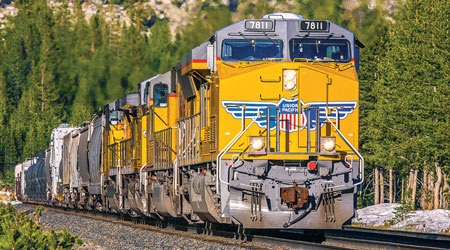
The Class I continually analyzes its hump yards, too. Such a deep dive prompted a $108 million upgrade to Englewood Yard in Houston — one of UP’s largest hump yards — that began in late 2019. Work is 90% complete and slated for completion in the second quarter, says Gehringer.
Project highlights include upgrading the hump computer system so the yard can hump more cars and extending 10 of the 64 bowl tracks from 2,500 to 2,800 feet to 5,500 feet.
The yard — which currently handles 2,400 to 3,000 cars a day — is vital to UP’s Southern Region that spans from Los Angeles to New Orleans and Kansas City, says Gehringer. Now, cars will be classified in fewer days.
“The yard will be more efficient in handling cars, which will go more directly from a customer to the hump,” says Gehringer.
Other work planned in 2021 targets additional efficiencies and productivity. The work is part of UP’s $2.9 billion capital spending plan, which is similar to last year’s budget. The Class I plans to spend $1.8 billion on infrastructure improvements, $535 million on capacity projects and commercial facilities, and $235 million on technology pursuits.
Siding extensions are again a key part of the capex strategy. The railroad last year extended 36 sidings from 8,000 or 9,000 feet to about 15,000 feet, and this year expects to extend 20 to 24 more, says Gehringer.
The longer sidings help with ongoing efforts to lengthen trains, but they also provide benefits for train meets, enabling the railroad to prioritize one passing train over another, he says.
“It all drops down to improving customer service,” says Gehringer. “We used to operate 750 to 850 trains a day, and now we’re down to 550 to 650.”
In 2021, UP also is considering several projects in the Los Angeles basin to help grow market share, and 20 to 50 smaller projects designed to reduce bottlenecks.
“The projects are high in benefits,” says Gehringer. “We do them for safety, reliability and productivity, as well as for maintenance and upkeep.”
Overall, UP is determined to be as efficient as possible to improve the reliability of its service product. The railroad also must continue to push productivity, says Gehringer.
“There are many opportunities for us to improve across all aspects of our operations,” he says. “We must seize upon those in order to fulfill the long-term goals of our railroad.”
Email questions or comments to jeff.stagl@tradepress.com.
Keywords
Browse articles on Union Pacific Railroad information technology Raul Jalali UP Vision NetControl PS Technology Beth Whited RailPrime The Manufacturing Institute environmental social and governance Science Based Targets initiative UPGo intermodal Kenny Rocker Eric GehringerContact Progressive Railroading editorial staff.


 2025 MOW Spending Report: Passenger-rail programs
2025 MOW Spending Report: Passenger-rail programs
 Gardner steps down as Amtrak CEO
Gardner steps down as Amtrak CEO
 Guest comment: Oliver Wyman’s David Hunt
Guest comment: Oliver Wyman’s David Hunt
 Women of Influence in Rail eBook
Women of Influence in Rail eBook
 railPrime
railPrime




